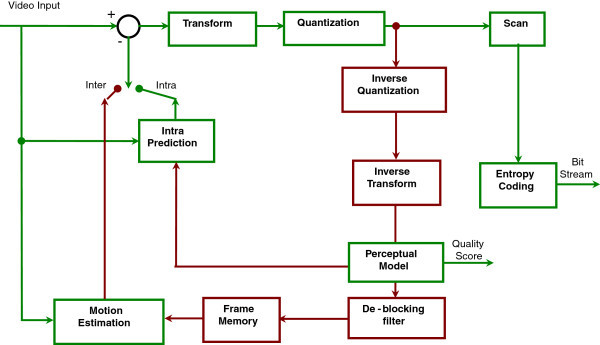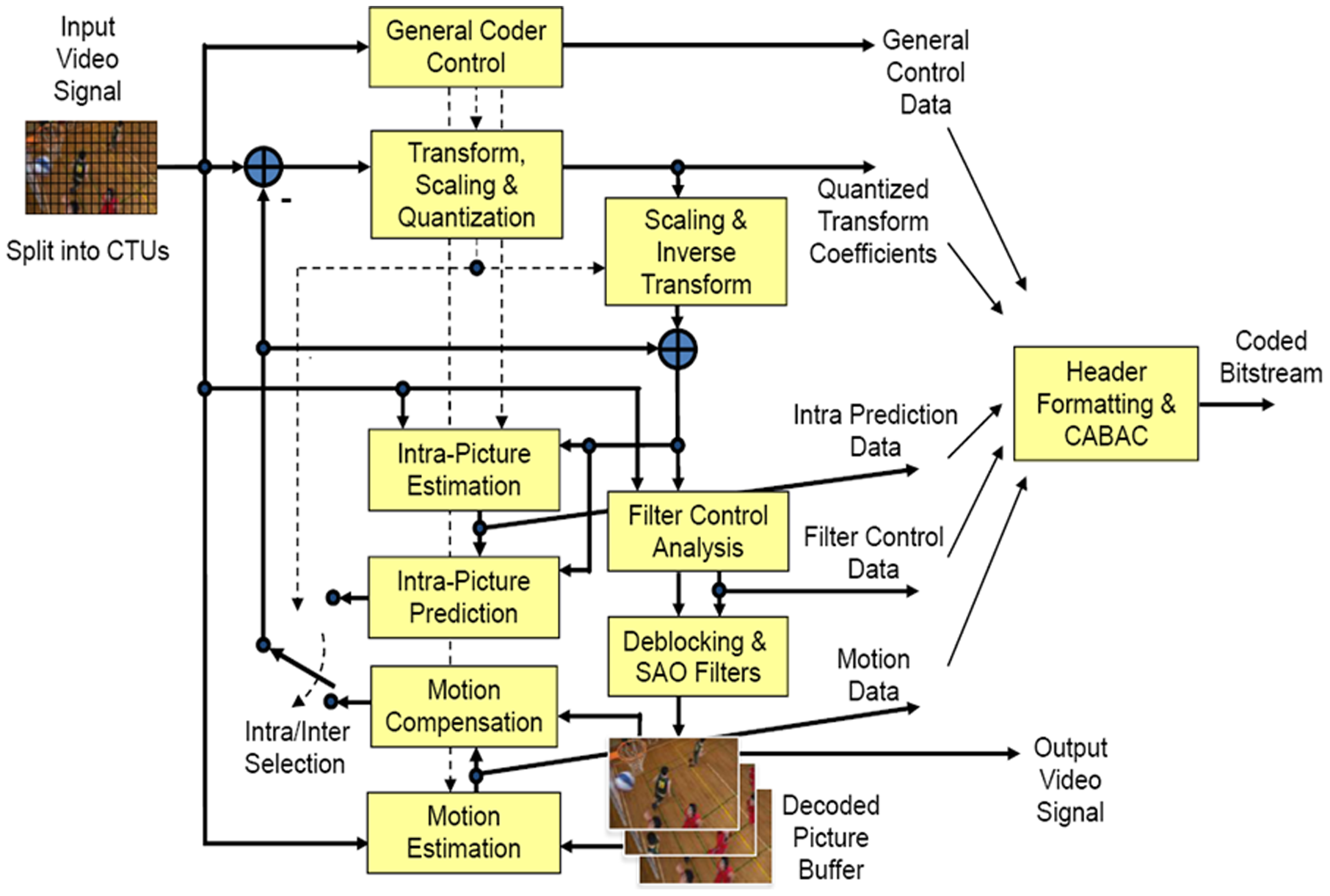|
H.264
Advanced Video Coding (AVC), also referred to as H.264 or MPEG-4 Part 10, is a video compression standard based on block-oriented, motion-compensated coding. It is by far the most commonly used format for the recording, compression, and distribution of video content, used by 84–86% of video industry developers . It supports a maximum resolution of 8K UHD. The intent of the H.264/AVC project was to create a standard capable of providing good video quality at substantially lower bit rates than previous standards (i.e., half or less the bit rate of MPEG-2, H.263, or MPEG-4 Part 2), without increasing the complexity of design so much that it would be impractical or excessively expensive to implement. This was achieved with features such as a reduced-complexity integer discrete cosine transform (integer DCT), variable block-size segmentation, and multi-picture inter-picture prediction. An additional goal was to provide enough flexibility to allow the standard to be appli ... [...More Info...] [...Related Items...] OR: [Wikipedia] [Google] [Baidu] |
High Efficiency Video Coding
High Efficiency Video Coding (HEVC), also known as H.265 and MPEG-H Part 2, is a video compression standard designed as part of the MPEG-H project as a successor to the widely used Advanced Video Coding (AVC, H.264, or MPEG-4 Part 10). In comparison to AVC, HEVC offers from 25% to 50% better data compression at the same level of video quality, or substantially improved video quality at the same bit rate. It supports resolutions up to 8192×4320, including 8K UHD, and unlike the primarily 8-bit AVC, HEVC's higher fidelity Main 10 profile has been incorporated into nearly all supporting hardware. While AVC uses the integer discrete cosine transform (DCT) with 4×4 and 8×8 block sizes, HEVC uses both integer DCT and discrete sine transform (DST) with varied block sizes between 4×4 and 32×32. The High Efficiency Image Format (HEIF) is based on HEVC. Concept In most ways, HEVC is an extension of the concepts in H.264/MPEG-4 AVC. Both work by comparing different parts of a fra ... [...More Info...] [...Related Items...] OR: [Wikipedia] [Google] [Baidu] |
Video Compression Standard
A video coding format (or sometimes video compression format) is a content representation format of digital video content, such as in a data file or bitstream. It typically uses a standardized video compression algorithm, most commonly based on discrete cosine transform (DCT) coding and motion compensation. A computer software or hardware component that compresses or decompresses a specific video coding format is a video codec. Some video coding formats are documented by a detailed technical specification document known as a video coding specification. Some such specifications are written and approved by standardization organizations as technical standards, and are thus known as a video coding standard. There are ''de facto'' standards and formal standards. Video content encoded using a particular video coding format is normally bundled with an audio stream (encoded using an audio coding format) inside a multimedia container format such as AVI, MP4, FLV, RealMedia, or Matro ... [...More Info...] [...Related Items...] OR: [Wikipedia] [Google] [Baidu] |
Video Coding Experts Group
The Video Coding Experts Group or Visual Coding Experts Group (VCEG, also known as Question 6) is a working group of the ITU Telecommunication Standardization Sector (ITU-T) concerned with standards for compression coding of video, images, audio signals, biomedical waveforms, and other signals. It is responsible for standardization of the "H.26x" line of video coding standards, the "T.8xx" line of image coding standards, and related technologies. Administratively, VCEG is the informal name of Question 6 (Visual, audio and signal coding) of Working Party 3 (Audiovisual technologies and intelligent immersive applications) of ITU-T Study Group 16 (Multimedia and related digital technologies). Its abbreviated title is ITU-T Q.6/SG16, or more simply, ITU-T Q6/16. The goal of VCEG is to produce ITU-T Recommendations (international standards) for video coding and image coding methods appropriate for conversational (e.g. videoconferencing and video telephony) and non-conversational (e ... [...More Info...] [...Related Items...] OR: [Wikipedia] [Google] [Baidu] |
Bit Rate
In telecommunications and computing, bit rate (bitrate or as a variable ''R'') is the number of bits that are conveyed or processed per unit of time. The bit rate is expressed in the unit bit per second (symbol: bit/s), often in conjunction with an SI prefix such as kilo (1 kbit/s = 1,000 bit/s), mega (1 Mbit/s = 1,000 kbit/s), giga (1 Gbit/s = 1,000 Mbit/s) or tera (1 Tbit/s = 1,000 Gbit/s). The non-standard abbreviation bps is often used to replace the standard symbol bit/s, so that, for example, 1 Mbps is used to mean one million bits per second. In most computing and digital communication environments, one byte per second (symbol: B/s) corresponds roughly to 8 bit/s. However if stop bits, start bits, and parity bits need to be factored in, a higher number of bits per second will be required to achieve a throughput of the same number of bytes. Prefixes When quantifying large or small bit rates, SI ... [...More Info...] [...Related Items...] OR: [Wikipedia] [Google] [Baidu] |
MPEG LA
MPEG LA was an American company based in Denver, Colorado that licensed patent pools covering essential patents required for use of the MPEG-2, MPEG-4, IEEE 1394, VC-1, ATSC, MVC, MPEG-2 Systems, AVC/H.264 and HEVC standards. Via Licensing Corp acquired MPEG LA in April 2023 and formed a new patent pool administration company called Via Licensing Alliance. History MPEG LA started operations in July 1997 immediately after receiving a Department of Justice Business Review Letter. During formation of the MPEG-2 standard, a working group of companies that participated in the formation of the MPEG-2 standard recognized that the biggest challenge to adoption was efficient access to essential patents owned by many patent owners. That ultimately led to a group of various MPEG-2 patent owners to form MPEG LA, which in turn created the first modern-day patent pool as a solution. The majority of patents underlying MPEG-2 technology were owned by three companies: Sony (311 patents) ... [...More Info...] [...Related Items...] OR: [Wikipedia] [Google] [Baidu] |
Inter Frame
An inter frame is a frame in a video compression stream which is expressed in terms of one or more neighboring frames. The "inter" part of the term refers to the use of ''Inter frame prediction''. This kind of prediction tries to take advantage from temporal redundancy between neighboring frames enabling higher compression rates. Inter frame prediction An inter coded frame is divided into blocks known as macroblocks. After that, instead of directly encoding the raw pixel values for each block, the encoder will try to find a block similar to the one it is encoding on a previously encoded frame, referred to as a reference frame. This process is done by a block matching algorithm. If the encoder succeeds on its search, the block could be encoded by a vector, known as motion vector, which points to the position of the matching block at the reference frame. The process of motion vector determination is called motion estimation. In most cases the encoder will succeed, but the block ... [...More Info...] [...Related Items...] OR: [Wikipedia] [Google] [Baidu] |
Video Compression
In information theory, data compression, source coding, or bit-rate reduction is the process of encoding information using fewer bits than the original representation. Any particular compression is either lossy or lossless. Lossless compression reduces bits by identifying and eliminating Redundancy (information theory), statistical redundancy. No information is lost in lossless compression. Lossy compression reduces bits by removing unnecessary or less important information. Typically, a device that performs data compression is referred to as an encoder, and one that performs the reversal of the process (decompression) as a decoder. The process of reducing the size of a data file is often referred to as data compression. In the context of data transmission, it is called source coding: encoding is done at the source of the data before it is stored or transmitted. Source coding should not be confused with channel coding, for error detection and correction or line coding, the means ... [...More Info...] [...Related Items...] OR: [Wikipedia] [Google] [Baidu] |
Blu-ray Disc
Blu-ray (Blu-ray Disc or BD) is a Digital media, digital optical disc data storage format designed to supersede the DVD format. It was invented and developed in 2005 and released worldwide on June 20, 2006, capable of storing several hours of high-definition video (HDTV 720p and 1080p). The main application of Blu-ray is as a medium for video material such as feature films and for the physical distribution of video games for the PlayStation 3, PlayStation 4, PlayStation 5, Xbox One, and Xbox Series X and Series S, Xbox Series X. The name refers to the blue laser used to read the disc, which allows information to be stored at a greater density than is possible with the longer-wavelength red laser used for DVDs, resulting in an increased capacity. The polycarbonate disc is in diameter and thick, the same size as DVDs and Compact disc, CDs. Conventional (or "pre-BDXL") Blu-ray discs contain 25gigabyte, GB per layer, with dual-layer discs (50GB) being the industry standard for fe ... [...More Info...] [...Related Items...] OR: [Wikipedia] [Google] [Baidu] |
Motion Compensation
Motion compensation in computing is an algorithmic technique used to predict a frame in a video given the previous and/or future frames by accounting for motion of the camera and/or objects in the video. It is employed in the encoding of video data for video compression, for example in the generation of files. Motion compensation describes a picture in terms of the transformation of a reference picture to the current picture. The reference picture may be previous in time or even from the future. When images can be accurately synthesized from previously transmitted/stored images, the compression efficiency can be improved. Motion compensation is one of the two key video compression techniques used in video coding standards, along with the discrete cosine transform (DCT). Most video coding standards, such as the H.26x and MPEG formats, typically use motion-compensated DCT hybrid coding, known as block motion compensation (BMC) or motion-compensated DCT (MC DCT). Functionality ... [...More Info...] [...Related Items...] OR: [Wikipedia] [Google] [Baidu] |
MPEG-4
MPEG-4 is a group of international standards for the compression of digital audio and visual data, multimedia systems, and file storage formats. It was originally introduced in late 1998 as a group of audio and video coding formats and related technology agreed upon by the ISO/IEC Moving Picture Experts Group (MPEG) (ISO/IEC JTC 1/SC29/WG11) under the formal standard ISO/IEC 14496 – ''Coding of audio-visual objects''. Uses of MPEG-4 include compression of audiovisual data for Internet video and CD distribution, voice (telephone, videophone) and broadcast television applications. The MPEG-4 standard was developed by a group led by Touradj Ebrahimi (later the JPEG president) and Fernando Pereira. Background MPEG-4 absorbs many of the features of MPEG-1 and MPEG-2 and other related standards, adding new features such as (extended) VRML support for 3D rendering, object-oriented composite files (including audio, video and VRML objects), support for externally specified ... [...More Info...] [...Related Items...] OR: [Wikipedia] [Google] [Baidu] |
MPEG
The Moving Picture Experts Group (MPEG) is an alliance of working groups established jointly by International Organization for Standardization, ISO and International Electrotechnical Commission, IEC that sets standards for media coding, including compression coding of audio compression (data), audio, video compression, video, graphics, and Compression of Genomic Sequencing Data, genomic data; and transmission and Container format (digital), file formats for various applications.John Watkinson, ''The MPEG Handbook'', p. 1 Together with Joint Photographic Experts Group, JPEG, MPEG is organized under ISO/IEC JTC 1/ISO/IEC JTC 1/SC 29, SC 29 – ''Coding of audio, picture, multimedia and hypermedia information'' (ISO/IEC Joint Technical Committee 1, Subcommittee 29). MPEG formats are used in various multimedia systems. The most well known older MPEG media formats typically use MPEG-1, MPEG-2, and MPEG-4 AVC media coding and MPEG-2 systems MPEG transport stream, transport streams an ... [...More Info...] [...Related Items...] OR: [Wikipedia] [Google] [Baidu] |





